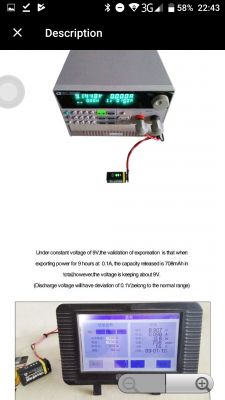In today's article I will test for you a Chinese, 9V reusable battery, charged via USB.
I have described it once tricked charger with the function of charging the 6F22 battery, the popular "nine-volt" , actually without this feature.
Several colleagues recommended the purchase of 9V Li-Ion batteries with a built-in inverter and charger inside. Just connect to any 5V charger with a micro USB plug to charge it.
I was tempted and ordered one piece for a trial.
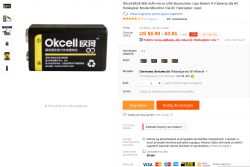
As of today, you can buy this particular model for ~ 26 Polish zlotys. Given the promised 1500 charge cycles and an hour (or one and a half, depending on the source of information) charging it looks quite interesting.
So I decided to purchase such an invention. The versions with a capacity of 1200mAh reign on Aliexpress, but somehow I did not believe it, so following the voice of "reason" (if you can say so, when you buy a Chinese cat in a Chinese bag ) I chose a battery with a capacity of 800mAh, it sounded more real to me, considering the dimensions, and remember that we also have a converter and a "charger" inside.
) I chose a battery with a capacity of 800mAh, it sounded more real to me, considering the dimensions, and remember that we also have a converter and a "charger" inside.
Now a few pics:


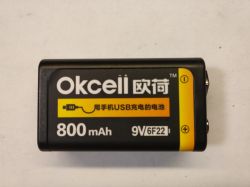
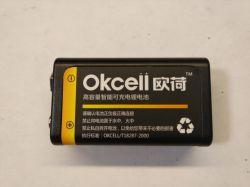
The battery is very light, weighs only 24.5g, which, despite the use of a plastic housing, suggests that we will not find too much of this lithium inside.
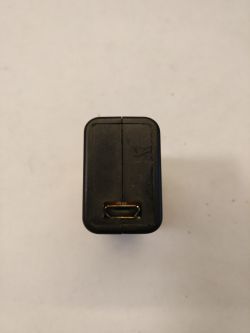
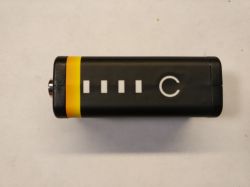
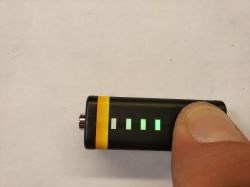
As we can see, the battery is equipped with a charge indicator, unfortunately it is completely useless, but more on that.
Now it's time for some technical data, although it's hard to find anything on the web:
- fast charging in an hour (although as I mentioned earlier, I also saw information that it is an hour and a half);
- the charge indicator is activated by the button, but as I mentioned, it is useless, because when the voltage at the battery terminals is 7.8V, the indicator shows 3/4 of capacity;
- rated voltage 9V;
- declared capacity 800mAh;
- charging with any 5VDC charger with a micro USB plug;
- lifetime of 1500 charging cycles (I bet a maximum of five hundred);
- charging current "Max.800mAh", I suspect it was about 800mA, which would correspond to the declared capacity and charging time of one hour;
- dimensions: 48.5 x 26.5 x 17.5 mm;
- weight, as I mentioned 24.5 grams, the manufacturer gives 28 grams, I do not know how much energy is stored for the missing 3.5 grams of lithium, but I suspect more than I think.
Everything looks beautiful so far. Let's move on to checking how much truth there is in this.
When I took the battery out of the packaging, I pressed the tester button and saw three LEDs on, four of which were possible, I did not think to measure the voltage at the battery terminals, but immediately connected it to the charger. It was lying for over an hour and a half, so if anything, it had to be fully charged. After "allegedly charging", I measured the voltage on the terminals and found that it was only 8.4V, so I connected it for 30 minutes, but the voltage did not increase any more.
This is the first time I am dealing with this type of invention, so I decided that it may be like that and that's it.
So we connect it, to an artificial load. Unfortunately, I do not know at what voltage the protection will work and turn off the inverter, but I know from experience that most devices work properly up to about 7.8V.
Yes, I know that they are still good at 5V, but I omit them. Average multimeter, or, for example, my pyrometer, featured here below 7.8V, they no longer give reliable measurement results.
For these reasons, I set the discharge voltage to just 7.8V on the artificial load.
Here I was very disappointed:
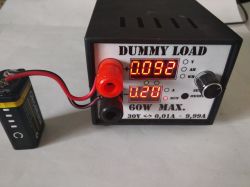
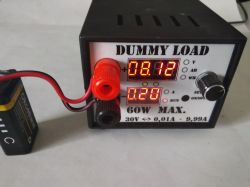

The artificial load used for the test was also presented on ours forum .


After the test, it turned out that the capacity actually contains the number 8, and there are even two eights ...
However, it is not as beautiful as it may seem, because the comma is in the wrong place.
And so I present to you the measurement result, voltage from 8.4V to 7.8V, current 200mA. Result expressed in Ah:
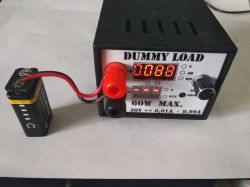

Yes, you can see the result is 0.088Ah.
I have already started a dispute and I am counting on a refund, because while with the real capacity of, say, 400mAh, I would be reconciled, or even happy, because it is still twice as much as the "normal 6F22 battery", the difference in the form of ten times the declared value is not acceptable.
I just hope that I just found a faulty copy and the seller will send a new one or return the money, and I will buy it again and test it. The very idea of Li-Ion cells built with the necessary converters / controllers in the 6F22 battery housing is very good, provided that it is done properly.
Or maybe one of the readers has the same "batteries" in their resources, or maybe even uses them every day and would be able to share their opinion? Which would reassure me that I was unlucky after all, or that this was rubbish.
Best regards.
CMS
EDIT 2018-06-07 17:11:
The Chinese wrote that the battery should be charged for five hours before the first use. As for me, this is just selling a client. The battery was plugged into the charger all night (I'll give her a shot ). At 7:30 am it had a voltage of 8.40V. I re-measured when I got with her to the company, it was 9:28, which is two hours after unplugging from the charger. I was a bit surprised, because it only had 8.37V, to be sure I checked it with two multimeters, the result was identical.
). At 7:30 am it had a voltage of 8.40V. I re-measured when I got with her to the company, it was 9:28, which is two hours after unplugging from the charger. I was a bit surprised, because it only had 8.37V, to be sure I checked it with two multimeters, the result was identical.
This time the capacity measurement looked different. The current was still set to 200mA, because in the case of capacitance measurement, it is impossible to set less in this load.
I set the lower threshold to 5.80V, i.e. 2.9V has a cell. I wasn't watching the readings all the time, but the last voltage I saw was 6.21V, when I looked the next time the battery was 0.0V (i.e. the protection was working) and the capacity meter showed 449mAh.
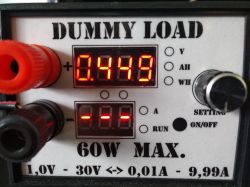
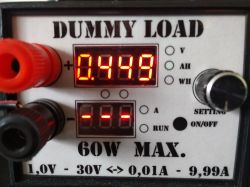
Nevertheless, after pressing the "test" button, one LED was on on the indicator.
In the meantime, I started looking for some information about these batteries and found somewhere in the depths of the Internet that these types of batteries should not be loaded with a current greater than 120mA. If this is the case, it looks like I have exaggerated with the load, and if so, I suspect that with a current of e.g. 100mA, the capacity may agree with the one stated on the battery label.
All the confusion, due to the lack of data on this particular battery.
I am glad that there was an interesting discussion, and also a bit of constructive criticism, as you can see, was useful.
I will try to measure the capacity while charging. I know this is not the best method, but with new cells, the results should be more or less acceptable.
Thank you for the motivation for further testing.
In this situation, I will probably end the dispute on Aliexpress, although I will present the results of the measurements to my Chinese friend and we will see what she says. After all, nowhere there is information about the permissible "safe" current, nor about how the manufacturer measured this capacity.
EDIT June 28, 2018 16:50:
The dispute with the Chinese dragged on a bit. He demanded that I record a video of the test. I asked if he was serious, because the test took about two hours and fifteen minutes, so the film would be long and heavy. I also wrote that I did not intend to waste any time on it.
The "judge" from Aliexpress entered and decided to pay the seller in full. I asked for the maximum discharge current of this battery but got no answer.
I will add that the battery is self-discharging quite quickly. I fully charged it after finishing the last test and it was lying there unused. Yesterday it had only 8V, and I would like to remind you that it has 8.4V when fully charged.
Best regards.
CMS
I have described it once tricked charger with the function of charging the 6F22 battery, the popular "nine-volt" , actually without this feature.
Several colleagues recommended the purchase of 9V Li-Ion batteries with a built-in inverter and charger inside. Just connect to any 5V charger with a micro USB plug to charge it.
I was tempted and ordered one piece for a trial.

As of today, you can buy this particular model for ~ 26 Polish zlotys. Given the promised 1500 charge cycles and an hour (or one and a half, depending on the source of information) charging it looks quite interesting.
So I decided to purchase such an invention. The versions with a capacity of 1200mAh reign on Aliexpress, but somehow I did not believe it, so following the voice of "reason" (if you can say so, when you buy a Chinese cat in a Chinese bag
Now a few pics:




The battery is very light, weighs only 24.5g, which, despite the use of a plastic housing, suggests that we will not find too much of this lithium inside.



As we can see, the battery is equipped with a charge indicator, unfortunately it is completely useless, but more on that.
Now it's time for some technical data, although it's hard to find anything on the web:
- fast charging in an hour (although as I mentioned earlier, I also saw information that it is an hour and a half);
- the charge indicator is activated by the button, but as I mentioned, it is useless, because when the voltage at the battery terminals is 7.8V, the indicator shows 3/4 of capacity;
- rated voltage 9V;
- declared capacity 800mAh;
- charging with any 5VDC charger with a micro USB plug;
- lifetime of 1500 charging cycles (I bet a maximum of five hundred);
- charging current "Max.800mAh", I suspect it was about 800mA, which would correspond to the declared capacity and charging time of one hour;
- dimensions: 48.5 x 26.5 x 17.5 mm;
- weight, as I mentioned 24.5 grams, the manufacturer gives 28 grams, I do not know how much energy is stored for the missing 3.5 grams of lithium, but I suspect more than I think.
Everything looks beautiful so far. Let's move on to checking how much truth there is in this.
When I took the battery out of the packaging, I pressed the tester button and saw three LEDs on, four of which were possible, I did not think to measure the voltage at the battery terminals, but immediately connected it to the charger. It was lying for over an hour and a half, so if anything, it had to be fully charged. After "allegedly charging", I measured the voltage on the terminals and found that it was only 8.4V, so I connected it for 30 minutes, but the voltage did not increase any more.
This is the first time I am dealing with this type of invention, so I decided that it may be like that and that's it.
So we connect it, to an artificial load. Unfortunately, I do not know at what voltage the protection will work and turn off the inverter, but I know from experience that most devices work properly up to about 7.8V.
Yes, I know that they are still good at 5V, but I omit them. Average multimeter, or, for example, my pyrometer, featured here below 7.8V, they no longer give reliable measurement results.
For these reasons, I set the discharge voltage to just 7.8V on the artificial load.
Here I was very disappointed:



The artificial load used for the test was also presented on ours forum .


After the test, it turned out that the capacity actually contains the number 8, and there are even two eights ...
However, it is not as beautiful as it may seem, because the comma is in the wrong place.
And so I present to you the measurement result, voltage from 8.4V to 7.8V, current 200mA. Result expressed in Ah:


Yes, you can see the result is 0.088Ah.
I have already started a dispute and I am counting on a refund, because while with the real capacity of, say, 400mAh, I would be reconciled, or even happy, because it is still twice as much as the "normal 6F22 battery", the difference in the form of ten times the declared value is not acceptable.
I just hope that I just found a faulty copy and the seller will send a new one or return the money, and I will buy it again and test it. The very idea of Li-Ion cells built with the necessary converters / controllers in the 6F22 battery housing is very good, provided that it is done properly.
Or maybe one of the readers has the same "batteries" in their resources, or maybe even uses them every day and would be able to share their opinion? Which would reassure me that I was unlucky after all, or that this was rubbish.
Best regards.
CMS
EDIT 2018-06-07 17:11:
The Chinese wrote that the battery should be charged for five hours before the first use. As for me, this is just selling a client. The battery was plugged into the charger all night (I'll give her a shot
This time the capacity measurement looked different. The current was still set to 200mA, because in the case of capacitance measurement, it is impossible to set less in this load.
I set the lower threshold to 5.80V, i.e. 2.9V has a cell. I wasn't watching the readings all the time, but the last voltage I saw was 6.21V, when I looked the next time the battery was 0.0V (i.e. the protection was working) and the capacity meter showed 449mAh.


Nevertheless, after pressing the "test" button, one LED was on on the indicator.
In the meantime, I started looking for some information about these batteries and found somewhere in the depths of the Internet that these types of batteries should not be loaded with a current greater than 120mA. If this is the case, it looks like I have exaggerated with the load, and if so, I suspect that with a current of e.g. 100mA, the capacity may agree with the one stated on the battery label.
All the confusion, due to the lack of data on this particular battery.
I am glad that there was an interesting discussion, and also a bit of constructive criticism, as you can see, was useful.
I will try to measure the capacity while charging. I know this is not the best method, but with new cells, the results should be more or less acceptable.
Thank you for the motivation for further testing.
In this situation, I will probably end the dispute on Aliexpress, although I will present the results of the measurements to my Chinese friend and we will see what she says. After all, nowhere there is information about the permissible "safe" current, nor about how the manufacturer measured this capacity.
EDIT June 28, 2018 16:50:
The dispute with the Chinese dragged on a bit. He demanded that I record a video of the test. I asked if he was serious, because the test took about two hours and fifteen minutes, so the film would be long and heavy. I also wrote that I did not intend to waste any time on it.
The "judge" from Aliexpress entered and decided to pay the seller in full. I asked for the maximum discharge current of this battery but got no answer.
I will add that the battery is self-discharging quite quickly. I fully charged it after finishing the last test and it was lying there unused. Yesterday it had only 8V, and I would like to remind you that it has 8.4V when fully charged.
Best regards.
CMS
Cool? Ranking DIY





